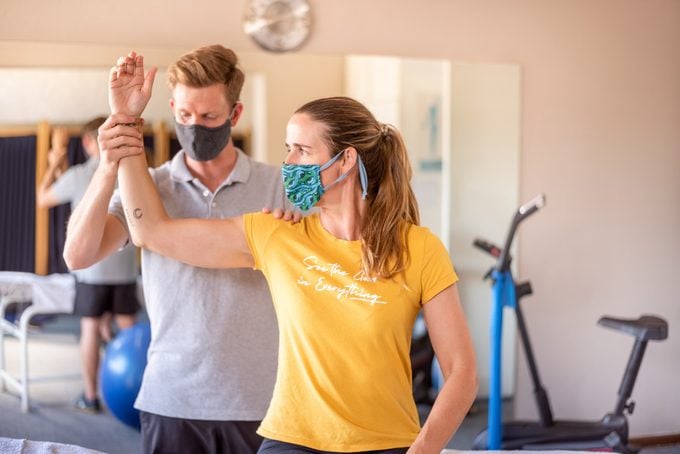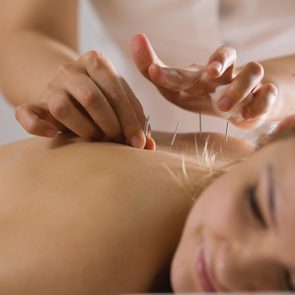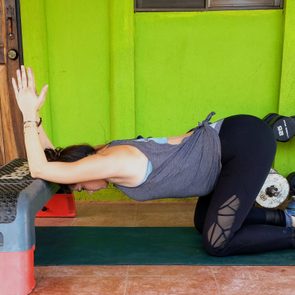What Is Tennis Elbow? Causes, Symptoms, and Treatment
Updated: Mar. 11, 2022
Tennis elbow doesn't just affect tennis players. Here's what you need to know to help alleviate and prevent this type of elbow pain.
What is tennis elbow?
Maybe you’ve been nursing nagging pain to the outside of your elbow for a while. Your grip strength feels weak, and you experience some pain when you extend your wrist backward. Your symptoms all seem to point to tennis elbow, but the last time you played tennis was way back in high school. So what gives?
“When it comes to conditions that can affect the elbow, there are many, and you can’t judge them all by their popular names,” says Brian Lee, MD, an orthopedic surgeon at Cedars-Sinai Kerlan-Jobe Institute in Los Angeles.
“Tennis elbow can happen to just about anyone, whether or not they play tennis.”

Tennis elbow in a nutshell
While tennis elbow is the colloquial name, the official name for this common degenerative, inflammatory condition is lateral epicondylitis. To be technical about the condition, you need to know that it affects the origin point of the extensor carpi radialis brevis (ECRB) muscle. If you’ve never heard of such a muscle, don’t beat yourself up. This muscle is one of the small muscles of your forearm that assists with extending your wrist.
If your arms are extended in front of you, with your palms facing down, this muscle helps you point your fingers forward, and it helps you pull your wrists back into hyperextension to point your fingers toward the ceiling.
This muscle (the extensor carpi radialis brevis) originates outside of your upper arm right above the elbow joint, and extends down along your forearm, inserting at the base of your middle finger. The reason tennis elbow is associated with pain to the outside of your elbow is because it’s due to inflammation at the origin point of this muscle.
“It’s thought to happen as a result of overuse of the extensor muscles,” says Dr. Lee. “Since just about everyone uses these muscles a considerable amount throughout the day, it’s probably no surprise that many of the people who develop tennis elbow don’t play tennis!”
(Use these stretches to relieve soreness after your workout.)
Symptoms of tennis elbow
Dr. Lee explains the general symptoms of tennis elbow include tenderness at the outside of the elbow, pain when extending the wrist and fingers, and often decreased grip strength.
That said, he warns you should be cautious about self-diagnosis.
“While pain at the lateral epicondyle, on the outside of the elbow, is most commonly lateral epicondylitis, other situations can cause pain in that area,” he says.
“Careful examination by a skilled physician is required to ensure a patient isn’t actually having symptoms from arthritis of the elbow, radial tunnel syndrome (compression of a nerve at the elbow), biceps tendonitis, or a rupture of the extensor wad itself.”
Most common treatment methods for tennis elbow
Often, when people are experiencing muscle, tendon, or ligament pain, especially at a major joint, they worry they may need surgery to correct the problem. Dr. Lee points out that for most people suffering from tennis elbow, surgery is unnecessary.
(Dealing with wrist and hand pain? Try these carpal tunnel syndrome treatments.)
Physical therapy

“I recommend physical therapy for a multifaceted treatment regimen that includes both icing and heating, anti-inflammatory measures, stretching, and eventual muscle stimulation and strengthening, including both eccentric and concentric strengthening exercises,” he says.
“I consider this protocol to be the mainstay of treatment, and it works by not only first helping the inflammation to subside, but eventually retraining and strengthening the muscles of the extensor wad so that it can subsequently function normally again.”
One thing to keep in mind, though, is that if you’re dealing with tennis elbow, you’re not going to start feeling better overnight.
“It’s essential to know that tennis elbow takes time to resolve, not uncommonly up to 12 months for full relief,” Dr. Lee says.
“Rehabilitation from this condition is more of a marathon than a sprint to get better. With that in mind, I encourage patients to take a less invasive to progressively more invasive approach.”
Alternatives
If tennis elbow doesn’t improve with physical therapy, looking into bracing, anti-inflammatory medication, injections, or a minimally invasive procedure may be in order, Dr. Lee says.
If you suspect tennis elbow, your first plan of action is to reduce inflammation and get a specific diagnosis. Go ahead and schedule a doctor’s appointment, and in the meantime, apply ice to help ease the pain, rest your arm and try to avoid doing movements that irritate it.
You can also take over-the-counter anti-inflammatories, like acetaminophen or naproxen, or you can apply a topical anti-inflammatory like Icy Hot or Bengay. Then, once you’ve gotten your specific diagnosis, work with your physical therapist to start a stretching and strengthening routine designed to alleviate symptoms and prevent future recurrence. If, after several months of faithful program adherence, you haven’t experienced improvement, talk about other options.
(Try these four stretches to help relieve tennis elbow pain.)
Options for bracing
Googling “tennis elbow treatments” will often land you on an Amazon page selling braces designed for this purpose. You may wonder if it’s worth giving one a try. While you should ask your doctor or physical therapist if it’s advised, it might actually be worth buying one and testing it out.
People use the wrist extensor muscles, including the ECRB, frequently in performing activities of daily living, according to Dr. Lee.
“So when someone experiencing tennis elbow attempts to perform movements such as driving, carrying groceries, working out, and typing, it can be excruciating and further stimulate the inflammatory response that should be avoided,” Dr. Lee says.
“While the injury heals, an adequately applied counterforce (elbow) brace allows the ECRB muscles to relax during activity. Patients will often feel immediate relief when performing wrist extension motions due to the support from the brace.”
Lee says most of the braces on the market are adequate, but he does have a few tips for finding a good one.
“I always advise my patients to look for a brace that’s circular, long enough to fit around the forearm, and allows for tightening—braces with Velcro allow you to customize the support to your elbow. Additionally, the brace should have a pad on its inner surface that fits over the muscle belly of the ECRB,” he says.
Using the brace 24/7 isn’t advised. Rather, use it throughout the day during activities when you tend to feel associated pain the most, then ditch it overnight or when you’re not using your forearms, like when you’re just hanging out and watching TV.
(Learn whether you should try a back brace, too.)
What to keep in mind about surgical intervention
Lee admits that, yes, surgical intervention can be quite effective at relieving tennis elbow pain, but it should generally be the last resort. If, after other attempts to alleviate the pain, your doctor suggests surgery.
Whether they suggest an arthroscopic surgery or an incision depends on the level of damage expected. Remember, this is a degenerative condition, so there may be quite a bit of damage to the tendon attaching the muscle to the bone.
“The procedure involves cleaning out or ‘debriding’ the degenerative tissue, and potentially placing an anchor into the bone with a suture passed around the residual tendon to aid in repairing the tissue,” Dr. Lee explains.
If it sounds somewhat complicated and invasive, that’s because it is. And that’s exactly why you should try other forms of treatment before diving headfirst into surgery—even if a surgery goes well, you’re still going to need to follow a physical therapy plan to maximize your recovery and results.
(Tips to recover from surgery faster.)
Don’t just live with the pain—it’ll likely get worse, not better
While most people with mild tennis elbow will experience at least some relief fairly quickly with the introduction of an appropriate program, there are times when more help is needed.
This is particularly true when someone has decided to “live with” the pain when it was unnecessary to do so, assuming it would eventually just go away.
“It’s crucial to have any unresolved pain in the elbow (or anywhere in the body) evaluated promptly by a qualified medical professional. Continuing to ‘play through’ pain or use injured muscles or tendons can make the problem worse. And more severe injuries of this nature take even longer to heal and may require more invasive intervention to repair,” Dr. Lee says.
“Pain, no matter how ‘mild,’ is a sign that something is amiss and needs to be addressed. If you’re experiencing elbow pain, no matter the level of severity, be sure to see a trained professional to have it evaluated.”
(Things your physical therapist probably knows about you.)















